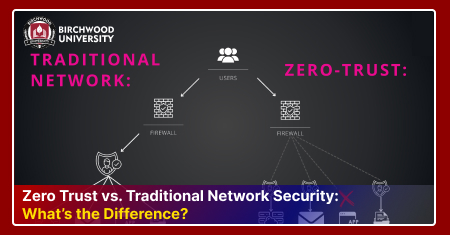AI, Blockchain & Zero Trust: What’s Driving Cybersecurity Education in 2025?
Jul 21, 2025The Cybersecurity Learning Shift in 2025
Cybersecurity field isn’t what it used to be. It is no longer just about blocking viruses or setting up firewalls. The internet has now been a battlefield where cybercriminals are using advanced tools like AI, deepfakes and automated attacks to break through security systems.
But here’s the real change:
The way in which cybersecurity is taught and learned is finally evolving. The traditional textbook learning is being replaced with practical and case study–based learning. Students today must be ready to fight modern threats using the same technologies that professionals use in the field. The most important tools amongst these are:
Blockchain Technology
Zero Trust Security
These are not just tech trends. They are the new foundation of cybersecurity across industries—from healthcare and banking to government and education.
That's why universities, colleges and online training platforms are restructuring their cybersecurity courses. What they want to do is to prepare learners with some applied experience in using tools and concepts that are actually in use out there today.
Key Cybersecurity Stats Driving the Need for Modern Education
$10.5 Trillion in Cybercrime Costs by 2025
According to Cybersecurity Ventures, global cybercrime damages are expected to hit $10.5 trillion annually by 2025—up from $3 trillion in 2015. This makes cybercrime the fastest-growing form of crime and now presents a more significant threat than natural disasters or global drug networks.
Source: Cybersecurity Ventures
3.5 Million Unfilled Cybersecurity Jobs
There will be over 3.5 million open cybersecurity positions globally in 2025, showing a major skills gap between what’s needed and what’s being taught.
Source: Cybersecurity Jobs Report
81% of Companies Now Back Zero Trust Models
A recent report by Zscaler found that 81% of businesses support Zero Trust architecture, and 62% plan to increase AI use in security operations—making these technologies core to any training program.
Source: Zscaler State of Cyberthreats & Protection Report
40% of Cyber Threats Use AI in Some Form
Cybersecurity company Darktrace reports that AI is now involved in over 40% of advanced cyberattacks, from phishing to identity spoofing.
Source: Darktrace AI Threat Report 2024
Blockchain Is Now Used in Academic Credentialing
Leading universities like MIT and UC Berkeley use blockchain to issue tamper-proof diplomas and certificates, reducing fraud and increasing employer trust.
Source: MIT Media Lab Digital Certificates Project
AI in Cybersecurity Education
● AI‑Powered Threat Detection
Modern cybersecurity courses now encompass modules in which students learn about how AI-based tools identify cyber threats. These tools are able to identify unusual login activity, phishing emails or new types of malware before a human analyst even detects them.
● Generative AI Simulations
Students use AI models like ChatGPT or BERT to simulate real attacks—like ransomware or social engineering. These simulations let students practice defense skills in real time.
● Adaptive Learning with AI
Interactive, AI-powered learning environments change based on student decisions. If a student makes a mistake in a virtual scenario, the lesson adapts. This method increases engagement and retention by over 30%.
Expected Skills Gained:
Machine Learning basics
Threat detection algorithms
Ethical AI use in security
Challenges:
Risk of over-relying on AI without human judgment
Need for ethical AI design in student projects
Blockchain in Cybersecurity Courses
● Verifiable Digital Credentials
Many schools now issue certificates and diplomas through blockchain. These cannot be faked or altered. Employers can verify student records instantly using QR codes tied to the blockchain.
● Decentralized Identity Management
Instead of storing personal data in one place, students learn to use digital wallets that hold their own academic records. This protects their data while keeping it shareable.
● Smart Contracts in Exams
Smart contracts can automate testing—releasing exam content only at certain times or locking down results securely.
Expected Skills Gained:
Understanding how blockchain works
Smart contract basics
Identity protection through decentralization
Challenges:
High cost to run blockchain labs
Learning curve for smart contract programming
Privacy concerns when working with sensitive data
Zero Trust Architecture in the Classroom
● Zero Trust Fundamentals
Zero Trust means “never trust, always verify.” Students learn that every access request—no matter where it comes from—must be verified. Topics include:
Micro-segmentation
Least privilege access
Identity verification
● Network Segmentation Labs
Students build labs where devices and users must re-authenticate to move between network zones. These hands-on exercises mimic how large companies protect their systems.
● Access Control Projects
Students practice setting up Multi-Factor Authentication (MFA) and monitor user behavior for unusual actions.
Expected Skills Gained:
Network design for Zero Trust
Policy building for access control
Identity-first security methods
Challenges:
Complexity in teaching layered access models
Cultural change from “trust by default” to “verify everything”
Need to balance usability with security
How AI, Blockchain and Zero Trust Work Together
● AI + Zero Trust
AI tools can analyze login behavior and network usage. If something looks suspicious, they raise an alert—fitting perfectly with Zero Trust.
● Blockchain + Identity for Zero Trust
Blockchain allows users to verify their identity without relying on a single company or system. This is ideal for Zero Trust setups.
● AI + Blockchain for Smart Monitoring
AI can scan and learn from logs stored securely on the blockchain. These logs can’t be changed, making them trustworthy for analysis.
How Cybersecurity Courses Are Built in 2025
Cybersecurity courses in 2025 are made to match the real skills companies need. Instead of only teaching theory from books, these courses now focus more on practical skills and real-world tools. Students learn by doing, not just by reading.
Here’s what a modern cybersecurity course looks like today:
Module 1: Learning AI for Cybersecurity
In this part of the course, students learn how Artificial Intelligence (AI) helps stop cyberattacks. They use tools that can find strange or risky behavior in a system. For example, the course may teach them to:
Spot fake login attempts
Detect phishing emails
Understand how malware acts
Students also get practice using simulations that show how real threats happen. This helps them get ready for real situations in a job.
Module 2: Using Blockchain to Keep Data Safe
This part teaches students how Blockchain helps protect records and identities online. It covers:
How to create digital records that can’t be changed
How students can store their own data in secure digital wallets
How smart contracts can run safely without anyone tampering with them
After this module, students understand how blockchain prevents fraud and keeps private information secure.
Module 3: Zero Trust Security System
This module focuses on the Zero Trust approach. The idea is simple: don’t trust anyone or anything without checking first. Students learn how to:
Use strong passwords and multi-factor logins
Break systems into small parts so only the right people can access them
Set rules for devices, apps and people to follow before they get access
They also build small network systems to test how Zero Trust works in action.
Module 4: Practice Through Labs and Activities
Here, students get to work on lab-based projects. They use everything they learned from AI, blockchain and Zero Trust. The labs might include:
Running a fake cyberattack and trying to stop it
Creating a digital certificate using blockchain
Making a network where access is tightly controlled
This helps students gain real experience with tools they’ll use in jobs.
In the last part of the course, students work in teams on a final project. They pick a topic and build a working solution. Some ideas include: A tool that uses AI to catch email scams A blockchain system that issues secure student IDs A full network model built with Zero Trust rules This project shows what they’ve learned and gives them something to show future employers. Cybersecurity roles now require more than basic IT skills. Companies want: AI threat modeling knowledge Experience with blockchain credentialing Familiarity with Zero Trust policies Organizations increasingly value candidates who understand AI-driven threat detection and Zero Trust architecture. According to the Zscaler State of Cyberthreats & Protection Report, 81% of firms back Zero Trust strategies and 62% plan to adopt AI in defense operations, making these highly relevant skills in today’s job market . Big institutions like ISACA and CompTIA now include AI and blockchain in their certification tracks. In India, regulators like RBI encourage companies to adopt AI-based defenses and Zero Trust models. Tools like OpenAI’s models are being trained to detect fake videos and manipulated speech used in scams. Google’s AI model “Big Sleep” found new SQLite vulnerabilities before public disclosure (Android Central). Universities like MIT, UC Berkeley and several in India now issue blockchain-based degrees. These reduce fraud and make hiring easier. Students don’t just learn how to use AI—they also learn how to keep it fair, unbiased and explainable. Teachers and trainers need to upskill in AI, smart contracts and advanced security concepts. Courses with real AI models or blockchain networks require powerful computers and internet access. Handling personal data in AI or blockchain environments must be done carefully. AI and security tools evolve quickly. Educators must update their material constantly to keep up. AI helps simulate cyberattacks and defenses. Students learn to spot and stop threats using tools like machine learning. Blockchain stores digital diplomas and certificates that can’t be changed or faked. Employers can verify these instantly. Zero Trust ensures no user or device is trusted by default. It reduces risks from insider threats and stolen credentials. Cybersecurity analyst, identity access manager, AI security researcher, Zero Trust architect. Cybersecurity in 2025 is changing fast—and so is the way students learn it. AI, blockchain and Zero Trust have become the new standard and today’s learners must gain real, hands-on experience. These tools are already being used by companies and learning the practical side of them will help students be ready to protect systems, fight new types of cyberattacks and build safer digital spaces for everyone.Module 5: Final Group Project
Career Impact: High Demand for AI & Blockchain Skills
● Industry Demand
● Global Push for Modern Cyber Training
Real-World Use Cases in Education
● AI Stops Deepfakes and Social Engineering
● Blockchain Diplomas Are Becoming Common
● Ethics in AI Training
Core Challenges in Teaching These Technologies
● Skills Gap
● Resource Intensive Labs
● Privacy & Ethics
● Fast-Changing Tools
FAQs
What is the role of AI in cybersecurity education?
How does blockchain help prevent credential fraud?
Why is Zero Trust important in 2025?
Which careers need AI and Zero Trust skills?
Conclusion






